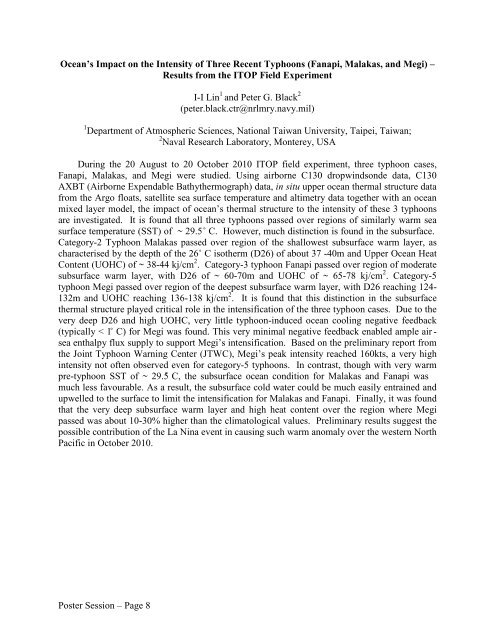65th IHC Booklet/Program (pdf - 4.9MB) - Office of the Federal ...
65th IHC Booklet/Program (pdf - 4.9MB) - Office of the Federal ...
65th IHC Booklet/Program (pdf - 4.9MB) - Office of the Federal ...
You also want an ePaper? Increase the reach of your titles
YUMPU automatically turns print PDFs into web optimized ePapers that Google loves.
Ocean’s Impact on <strong>the</strong> Intensity <strong>of</strong> Three Recent Typhoons (Fanapi, Malakas, and Megi) –<br />
Results from <strong>the</strong> ITOP Field Experiment<br />
I-I Lin 1 and Peter G. Black<br />
( peter.black.ctr@nrlmry.navy.mil)<br />
1 Department <strong>of</strong> Atmospheric Sciences, National Taiwan University, Taipei, Taiwan;<br />
2 Naval Research Laboratory, Monterey, USA<br />
2<br />
During <strong>the</strong> 20 August to 20 October 2010 ITOP field experiment, three typhoon cases,<br />
Fanapi, Malakas, and Megi were studied. Using airborne C130 dropwindsonde data, C130<br />
AXBT (Airborne Expendable Bathy<strong>the</strong>rmograph) data, in situ upper ocean <strong>the</strong>rmal structure data<br />
from <strong>the</strong> Argo floats, satellite sea surface temperature and altimetry data toge<strong>the</strong>r with an ocean<br />
mixed layer model, <strong>the</strong> impact <strong>of</strong> ocean’s <strong>the</strong>rmal structure to <strong>the</strong> intensity <strong>of</strong> <strong>the</strong>se 3 typhoons<br />
are investigated. It is found that all three typhoons passed over regions <strong>of</strong> similarly warm sea<br />
surface temperature (SST) <strong>of</strong> ~ 29.5 ˚ C. However, much distinction is found in <strong>the</strong> subsurface.<br />
Category-2 Typhoon Malakas passed over region <strong>of</strong> <strong>the</strong> shallowest subsurface warm layer, as<br />
characterised by <strong>the</strong> depth <strong>of</strong> <strong>the</strong> 26 ˚ C iso<strong>the</strong>rm (D26) <strong>of</strong> about 37 -40m and Upper Ocean Heat<br />
Content (UOHC) <strong>of</strong> ~ 38-44 kj/cm 2 . Category-3 typhoon Fanapi passed over region <strong>of</strong> moderate<br />
subsurface warm layer, with D26 <strong>of</strong> ~ 60-70m and UOHC <strong>of</strong> ~ 65-78 kj/cm 2 . Category-5<br />
typhoon Megi passed over region <strong>of</strong> <strong>the</strong> deepest subsurface warm layer, with D26 reaching 124-<br />
132m and UOHC reaching 136-138 kj/cm 2 . It is found that this distinction in <strong>the</strong> subsurface<br />
<strong>the</strong>rmal structure played critical role in <strong>the</strong> intensification <strong>of</strong> <strong>the</strong> three typhoon cases. Due to <strong>the</strong><br />
very deep D26 and high UOHC, very little typhoon-induced ocean cooling negative feedback<br />
(typically < 1˚ C) for Megi was found. This very minimal negative feedback enabled ample air -<br />
sea enthalpy flux supply to support Megi’s intensification. Based on <strong>the</strong> preliminary report from<br />
<strong>the</strong> Joint Typhoon Warning Center (JTWC), Megi’s peak intensity reached 160kts, a very high<br />
intensity not <strong>of</strong>ten observed even for category-5 typhoons. In contrast, though with very warm<br />
pre-typhoon SST <strong>of</strong> ~ 29.5 ˚ C, <strong>the</strong> subsurface ocean condition for Malakas and Fanapi was<br />
much less favourable. As a result, <strong>the</strong> subsurface cold water could be much easily entrained and<br />
upwelled to <strong>the</strong> surface to limit <strong>the</strong> intensification for Malakas and Fanapi. Finally, it was found<br />
that <strong>the</strong> very deep subsurface warm layer and high heat content over <strong>the</strong> region where Megi<br />
passed was about 10-30% higher than <strong>the</strong> climatological values. Preliminary results suggest <strong>the</strong><br />
possible contribution <strong>of</strong> <strong>the</strong> La Nina event in causing such warm anomaly over <strong>the</strong> western North<br />
Pacific in October 2010.<br />
Poster Session – Page 8
















